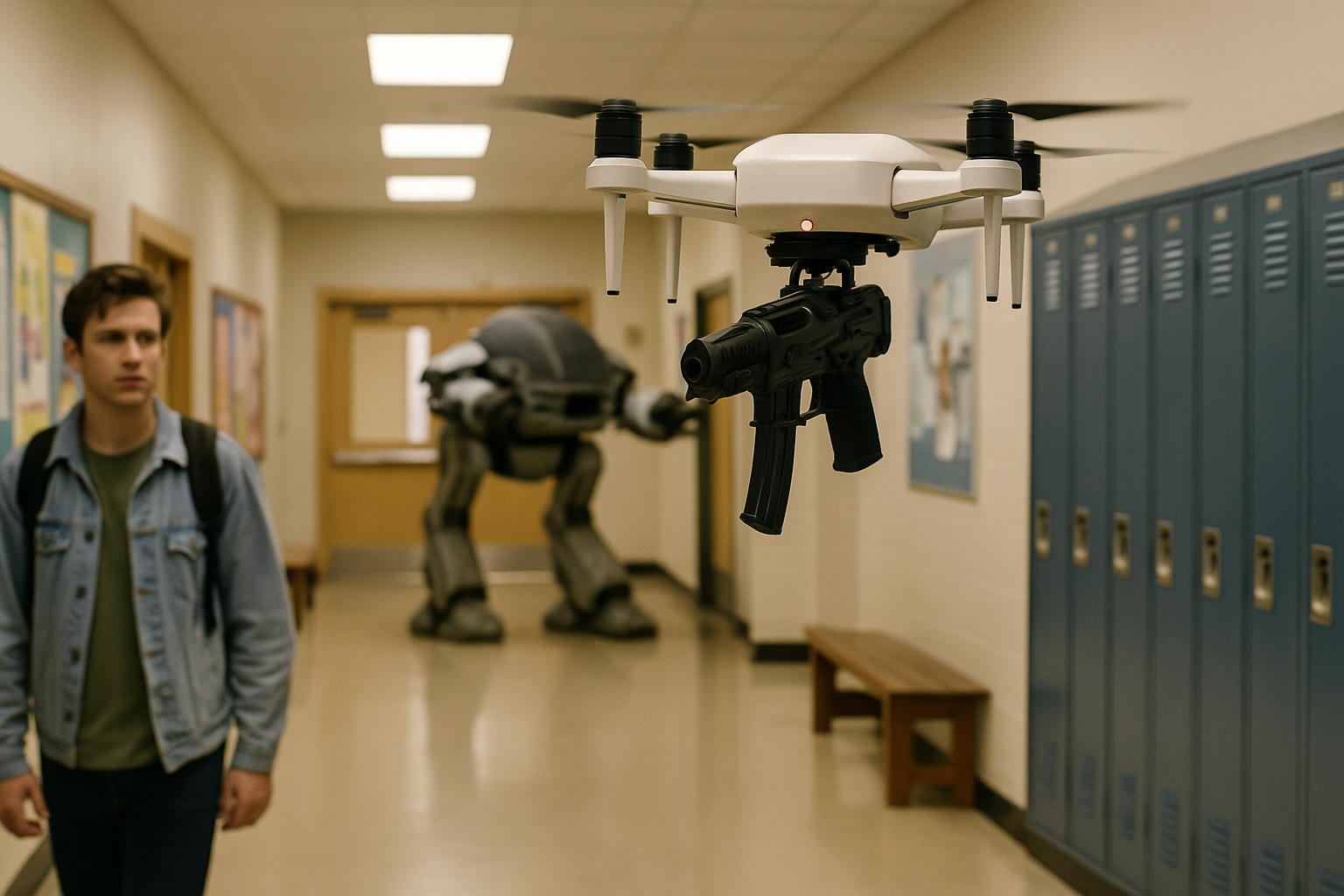The Washington Eye
An idea once confined to the pages of science fiction is now a reality in American school hallways. In response to the nation’s ongoing crisis of school shootings, a Texas-based startup has begun installing remote-controlled drones armed with “less-lethal” weapons inside schools, a move hailed by proponents as a life-saving innovation but condemned by critics as a dangerous leap into a dystopian future.
The company, Campus Guardian Angel, has developed a system where laptop-sized drones are stored in discreet boxes on campus. When an alarm is triggered, these drones can be deployed in seconds, piloted not by anyone in the school, but by operators in a central command hub in Austin. The company’s CEO, Justin Marston, claims their system can neutralize a threat in under a minute. “Our goal is to respond in five seconds, to be on the shooter in 15 seconds, and to degrade or incapacitate in 60 seconds,” Marston stated.
The drones are not autonomous but are equipped with an arsenal designed to incapacitate, including pepper spray launchers, high-decibel sirens, and disorienting flash-bang devices. The core selling point is speed, offering an immediate response that could circumvent the catastrophic law enforcement delays seen in tragedies like the 2022 Uvalde shooting.
This technology is moving rapidly from concept to implementation. Pilot programs are already underway in Texas’s Boerne ISD, with demonstrations held for other major districts. The concept is gaining political traction, with Florida Governor Ron DeSantis approving over half a million dollars to fund similar pilot programs in three Florida school districts. For a monthly subscription fee of around $4 per student, plus hardware costs, schools can hire the private company to provide a remote, armed response.
The introduction of these systems inevitably draws comparisons to decades of science fiction warnings. The most striking parallel is to the 1987 film RoboCop, where the Enforcement Droid Series 209 (ED-209), a heavily armed robot built by a private corporation, gruesomely malfunctions during a boardroom demonstration. The film serves as a potent allegory for the dangers of privatizing public safety and the potential for catastrophic failure when complex, armed technology is rushed to market to solve social problems.
Other cinematic portrayals highlight the deep ethical quandaries. The 2015 film Eye in the Sky explores the moral calculus of remote-controlled force, depicting the immense psychological toll on drone pilots and the diffusion of responsibility when life-or-death decisions are passed through a long chain of command. In the film, pilots, commanders, and politicians all struggle to accept the moral weight of a single strike, a scenario that mirrors the potential accountability vacuum for a school drone. If a tragic error occurs, who is responsible: the remote pilot, the company’s CEO, or the school board that signed the contract?
This question is at the heart of the fierce opposition from civil liberties groups. The American Civil Liberties Union (ACLU) and the Electronic Frontier Foundation (EFF) have long warned against the weaponization of domestic drones. Their primary concern is “mission creep”—the inevitable expansion of a technology from its initial, extreme justification to more routine uses. They argue that drones installed to stop a mass shooter will eventually be used to monitor student protests, break up fights, and enforce minor school rules, creating an environment of pervasive surveillance that disproportionately affects students of color.
This concern was validated in a stunning rebuke from within the tech industry itself. In 2022, when Taser-developer Axon proposed a similar drone for schools, the majority of its own, hand-picked AI Ethics Board resigned in protest. In a public letter, the former board members warned that the “video game” nature of remote engagement could dehumanize targets and lower the threshold for using force.
Educators and their unions have echoed these fears. The National Education Association (NEA), the nation’s largest labor union, has consistently rejected proposals to introduce more weaponry into schools, arguing it makes them more dangerous, not less. “Bringing more guns into our schools does nothing to protect our students and educators from gun violence,” said NEA President Becky Pringle. “Teachers should be teaching, not acting as armed security guards.” Opponents argue that funds for high-tech security systems would be better spent on preventative measures, such as hiring more school counselors and psychologists.
Beyond the ethical debate lies a legal minefield. Federal law prohibits operating a drone armed with a “dangerous weapon,” a term defined as anything “readily capable of, causing death or serious bodily injury.” Proponents claim their “less-lethal” payloads fall outside this definition, but critics argue that weapons like pepper spray and Tasers can and do cause serious harm or death. Furthermore, the legal standard for use of force by law enforcement relies on the “objectively reasonable” actions of an officer on the scene—a standard that is difficult, if not impossible, for a remote pilot hundreds of miles away to meet.
As school districts weigh this new option, they face a profound choice. The promise of a “guardian angel” in the machine offers a seductive, simple solution to an unspeakably complex problem. But critics warn that in the rush to adopt it, we risk creating a cure worse than the disease, transforming schools from places of learning and trust into high-tech fortresses patrolled by the ever-present eye of a private, remote authority.
At The Washington Eye, we investigate the untold stories shaping U.S. foreign policy.
















